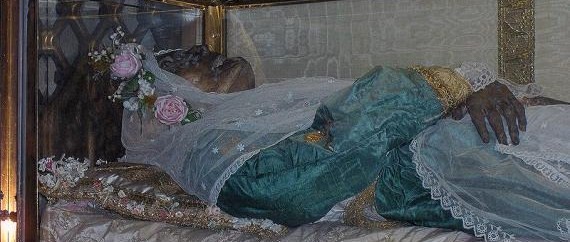Zombie, Vampire or Saint?

A grave disturbed, the coffin opened, and the body of a young girl, years dead, freakishly un-decomposed: Undead monster or miracle of faith? It depends on who’s asking.
Under other circumstances, being discovered in a state of less than natural rot can be bad news for a corpse. In Germany and Italy such undecayed dead were considered highly suspect and likely to be named vampire and have a brick crammed in their undead mouth.
But the rules are different for potential saints. Where some see evidence of the rampaging undead, and others might see a really just slightly-less-than-funky corpse, the right people saw what has been come to be called “incorruptibility” - which is a good thing if you want to be saint. It’s also a good thing if you are a local church that would like to lure visitors by displaying a dead lady in a box for a few hundred years.
First class relics, or bodies and parts of bodies of saints, have long been among the Catholic church’s most revered artifacts, and these “Incorruptibles” are the best one might ask for, in terms of attracting the curious masses into your church. The mysteriously preserved body of a the particularly pious were seen as an indication of potential saintliness, their exhumed bodies expected to give off a sweet odor known as the “Odor of Sanctity”. This alone was not reason for canonization, but it was a step in the right direction.
There are in reality, many reasons a corpse might not decay at a normal rate. In cases of a cold and humid environment, a process known as adipocere can transform the body’s fat into a waxy substance resistant to decay. Bodies buried in lime can become saponified, transforming that fat into something akin to soap. And finally, a dry environment can of course naturally produce the kind of mummies our favorite Wild West museums have propped up in corners.
Whatever the cause, there are LOTS of dessicated saints on display, some dating back hundreds of years and others recent enough to have been photographed in life.
In some cases, the term “incorruptible” seems perhaps overly generous. When the devout and lovely-in-life Bernadette of Lourdes was exhumed in 1919, a witness described the body thus:
Readers of the above might be surprised to find out that not only was this considered good news and proof of incorruptibility, but that her mildewed and skinless corpse has been on display in a fairy tale style glass coffin for nearly a hundred years, and is widely considered to be among the most beautiful of the holy dead. However, seekers of proof of the miraculous might benefit from knowing that the hauntingly beautiful face and hands seen by thousands of pilgrims were in fact made by a designer of fashion mannequins in Paris.
UNDEAD UNDEAD UNDEAD
ST. BERNADETTE OF LOURDES, Nevers, France
ST. ZITA Lucca, Italy
ST. FRANCIS XAVIER, Goa, India
ST. CATHERINE OF SIENA’S SEVERED HEAD, Siena, Italy
ST. CATHERINE OF BOLOGNA, Bologna, Italy











Follow us on Twitter to get the latest on the world's hidden wonders.
Like us on Facebook to get the latest on the world's hidden wonders.
Follow us on Twitter Like us on Facebook